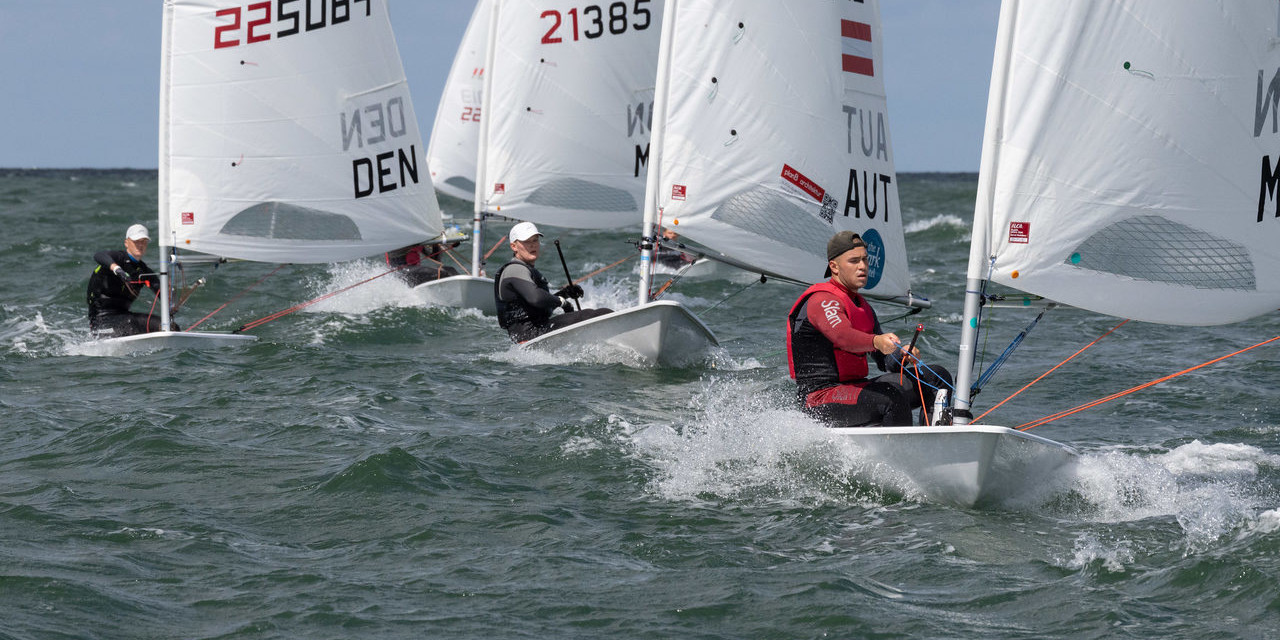8th Monaco Energy Boat Challenge – Conference 8th of July
During the Monaco Energy Boat Challenge, a day of talks and discussions took place on Thursday 8th July for an audience of experts in the Ballroom at the Yacht Club de Monaco and online to reflect on initiatives and solutions to decarbonise recreational boats. Twelve speakers took turns at the podium during a day divided into four sessions: current energy mix and alternative fuels; propulsion solutions; new materials; and vessel Lifecycle Analysis initiatives to give a panoramic, technical and succinct view of the issues.
The day started with a keynote speech by Bastien Bornand, energy engineer in the EODev design office, giving a very detailed analysis of the entire spectrum of energy and fuel solutions for vessel propulsion – download presentation here. His scientific analysis put the topic into perspective highlighting the fact that to date there is no universal solution, and will not be one tomorrow, as the majority of answers lie in how technologies evolve in the years to come – it will be talked about later for hydrogen – and above all how usage profiles fit the appropriate energy mix.
Focusing on the environmental impacts of CO2, NOx, SOx and particulate emissions, without taking into account the economic aspect, Bastien Bornand explained for example how “grey” hydrogen, produced partly from fossil fuels, is actually worse for the planet than using conventional fuels. He also highlighted the relevance of using intermittent renewable sources, solar in particular, in combination with storage solutions such as batteries or hydrogen, as long as they are “green”, in other words produced from renewable sources such as wind power or biomass – when biomass can be used without harming the environment. He also detailed why bio-fuels and synthetic fuels are valid short-term solutions to significantly reduce CO2 emissions, but are not a panacea and will not in his view provide a satisfactory response to energy needs as a whole.
The next speaker, Gregory Romano from Romano Energy which specialises in biofuels, was more optimistic. Extolling their merits in the greenhouse gas battle, he estimated that R&D on production of what he referred to as “fourth generation” biofuels was sufficiently successful to open up satisfactory prospects, while admitting that in the long term this response would not address all usages.
Niels Joyeux, CEO of Zephyr & Borée then demonstrated, with the VPLP OceanWings already tested on Energy Observer and in the process of being installed on the Ariane Group’s rocket parts cargo vessel, Canopée, that wind power was very topical, particularly in freight transport – or how to exploit an antediluvian principle with today’s technologies – even though there is still a lack of interest from the majority of the yachting sector in these solutions.
The next session focused on propulsion system development. From optimised Zenoro diesel generators to the strategy of Cummins, the world’s leading diesel engine producer which is now developing fuel cell and hydrogen based solutions, everyone recognises that yachting’s future is “electric”, especially hybrid technology combining batteries and hydrogen whatever its storage form.
Taking a real life case study, Stéphane Jardin of EODev demonstrated how establishing the usage profile of a yacht enabled them to calculate an intelligent optimised hybrid system combining the advantages of batteries for instant power with hydrogen fuel cells to increase a boat’s autonomy. The message was clear: when battery usage is limited by weight, volume and price to obtain the necessary power, recourse to hydrogen makes it possible to respond to bulk-volume issues, even with gas storage at only 350 bars, and in reality is more accessible.
Above all, given the presence of Hynova at the Monaco Energy Boat Challenge, he explained that this solution was already available and could now replace all-electric, even diesel-electric hybrids – at least on average-sized yachts to start with, while hydrogen storage options and power needs did not yet allow superyachts to be equipped satisfactorily with this solution for propulsion, but only for life on board.
This section, placed under the aegis of the Superyacht Eco Association, co-founded by the Yacht Club de Monaco and Crédit Suisse, and initiator of the SEA Index (a tool for assessing the carbon impact of superyachts), reminded us that if propulsion is an important factor in determining the environmental impact generated by yachting, it’s not the one. Indeed, life on board is another major factor to be taken into account, which the SEA Index can do by also evaluating the generator carbon emissions of superyachts over 40m.
After the morning’s discussions on fuel sources and propulsion systems, attention turned in the afternoon to new recyclable or natural composites that can be used in boat building, including for structural elements.
The presentation by Paolo Manganelli and Nicolas Siohan from Gurit, a company specialising in composite materials and present in all mobility sectors as well as construction, highlighted how the Lifecycle Analysis of various materials associated with different propulsion solutions changes a vessel’s total environmental impact. A demonstration that the entire yacht build and manufacturing chain and its usage must be taken into account to fully appreciate its ecological efficiency in line with conclusions from the morning’s session.
However, there are reasons to be optimistic in this area too. Be it the composite fibre developed by Permare & Amer Yachts in partnership with Bologna University, based on basalt and presented by Barbara Amerio, or the Cobratex bamboo composite proposed by Edouard Sherwood, it is clear a revolution in this field is underway.
But the speakers agree that as with fuels and propulsion systems there are still many obstacles to overcome before it is taken up on a mass scale: from regulatory restrictions to the time required to get approval for new technology from the relevant authorities and educate users to feel confident about leaving their comfort zone, these innovators’ mission is a long-term undertaking which sadly often comes up against an economical rather than ecological-centric approach to the energy transition.
The final session, devoted to initiatives developed to shift the lines comparing the technology aspect of the evolution required to protect our environment to the cost, highlighted the work being done by Paris 2024 in its Olympic Games preparations and by World Sailing to achieve carbon neutrality in developing nautical events worldwide before, during and after these big meetings by linking these objectives to the business opportunities that may result.
This is how Georgina Grenon, for Paris 2024, and Dan Reading for World Sailing, explained how they have implemented Lifecycle Analysis tools for better awareness among teams as well as the general public and their suppliers of the avenues to go down to noticeably reduce everyone’s impact on the environment. Adopting the adage “God helps those who help themselves”, they explained that this working together at all times coupled with a necessarily holistic long-term vision based on specified, proven methodologies, was also for them a way to convince end-users and consumers to change the way they operate, and be a driving force behind the ecological transition.
It is an approach that also applies to luxury yachting, where owners, naval architects, shipyards and equipment manufacturers need to be at the forefront of the paradigm shift, and work together to adopt solutions that this conference has shown are not just a distant dream but a reality today. That is what the Superyacht Eco Association (SEA) and its Index aim to promote.
Moreover, this is the whole object and objective of the Communauté Portuaire de Paris (CPP) that Grégoire Jourdan Gassin champions. Following indepth work on all types of boats on the Seine, he explained that detailed analyses of six profiles (from river boats to barges to pushers) had made it possible to launch pilot projects to convert several vessels to clean solutions, primarily electric to start with, while also establishing a suitable infrastructure and financial support for operators to help them go down this road.
In the same spirit, Guillaume Arnauld des Lions from the French Fédération des Industries Nautiques (FIN) described how it is now possible for any owner of a French flagged boat from 2m to 24m that has reached the end of its useful life and they don’t know what to do with it, can have it dismantled and recycled where possible for no charge. An initiative a priori unique in Europe even in the world, it has already taken 2,500 boats off the register in 18 months.
To summarise the day’s conclusions, it can be said that while there is no miracle solution there are a host of propositions linked to mature technological advances that should be adopted, depending on needs and uses. But above all, sectors need to accelerate the move towards ensuring that infrastructure, regulations, political decisions and financial support are in place to support progress and initiatives, rather than the other way round.
Dernières publications
15 July 2024
Celebration of youth
Celebration of youth Youth Sailing World Championships – Riva del Garda 15-19 July 2024 The…
14 July 2024
Monegasques out in force
Monegasques out in force French Open - Quiberon 11-14 July Laser sailors from Yacht Club de…
14 July 2024
Consistency on every start
Consistency on every start ILCA 7 - EurILCA Europa Cup GER – Warnemünde 6-14 July Consistency was…



